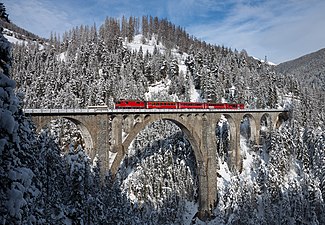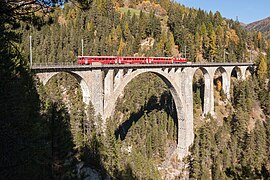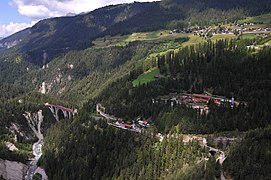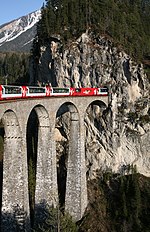
Preda is a small village within the Swiss municipality of Bergün Filisur, district of Albula, Canton Graubünden (Grisons), in the East of Switzerland.
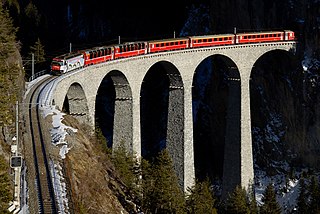
The Landwasser Viaduct is a single-track six-arched curved limestone railway viaduct. It spans the Landwasser between Schmitten and Filisur, in the canton of Graubünden, Switzerland.

Filisur is an Alpine village and former municipality in the Albula Region in the canton of Graubünden in Switzerland. The village sits on a hillside with a view to the west where the two rivers Albula/Alvra from the Albula Pass and Landwasser from Davos meet. On 1 January 2018 the former municipalities of Bergün/Bravuogn and Filisur merged into the new municipality of Bergün Filisur.

The Bernina Express is a train connecting Chur in Switzerland to Poschiavo in Switzerland and Tirano in Italy by crossing the Swiss Engadin Alps. For most of its journey, the train also runs along the World Heritage Site known as the Rhaetian Railway in the Albula / Bernina Landscapes.

The Albula Railway is a single track metre gauge railway line forming part of the so-called core network of the Rhaetian Railway (RhB), in the canton of Graubünden, Switzerland. It links Thusis on the Hinterrhein at 697 m (2,287 ft) and Filisur at 1,080 m (3,540 ft) with the spa resort of St. Moritz in Engadine at 1,774 m (5,820 ft).

Filisur railway station is a railway station in the municipality of Filisur, in the Swiss canton of Graubünden. It is located at the junction of the 1,000 mmmetre gauge Albula and Davos Platz–Filisur lines of the Rhaetian Railway. Hourly services operate on both lines.

The Gründjitobel Viaduct is a single track reinforced concrete railway bridge, spanning the Gründjitobelbach near Langwies, in the Canton of Graubünden, Switzerland.

The Langwieser Viaduct is a single track reinforced concrete railway bridge spanning the Plessur River and the Sapünerbach, near Langwies, in the Canton of Graubünden, Switzerland.

The Solis Viaduct is a single track eleven-arched limestone railway viaduct. It spans the Albula east of the hamlet of Solis, in the canton of Graubünden, Switzerland.

The Schmittentobel Viaduct is a single track limestone railway viaduct. It is situated near Schmitten, in the Canton of Graubünden, Switzerland.

The Brusio spiral viaduct is a single-track nine-arched stone spiral railway viaduct on the Bernina Railway. It was opened on 1 July 1908.

The Castielertobel Viaduct is a single track railway bridge spanning the Castielertobelbach, and linking the municipalities of Castiel and Calfreisen, in the Canton of Graubünden, Switzerland. It was built between 1913 and 1914 for the Chur–Arosa railway, and is now owned and used by the Rhaetian Railway.

Bergün Filisur is a municipality in the Albula Region in the canton of Graubünden in Switzerland. On 1 January 2018 the former municipalities of Bergün/Bravuogn and Filisur merged to form the new municipality of Bergün Filisur.

The Reichenau-Tamins–Disentis/Mustér railway is a Swiss metre-gauge railway, which is operated by the Rhaetian Railway. It connects the stations of Reichenau-Tamins and Disentis/Mustér.
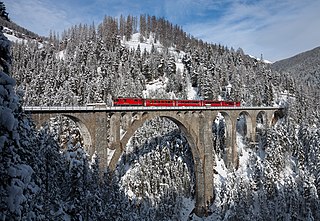
The Davos Platz–Filisur railway is a Swiss metre-gauge railway, which is operated by the Rhaetian Railway and has connected the spa town of Davos with Filisur on the Albula Railway since 1909. It represents a continuation of the Landquart–Davos Platz railway. The line is consistently single-track, apart from the stations, and has been electrified since 1919.
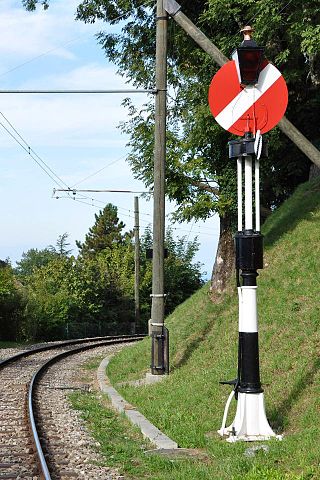
The hippsche Wendescheibe or Hipp’sche Wendescheibe , is a historical railway signal. The automatic and visual signal served as distant signals and home signals. Its main advantage was that energy to move the signal was provided locally, while the low power impulse to move the signal was transmitted electrically from the signal box, thus minimizing cumbersome and unreliable energy transmission over distance.
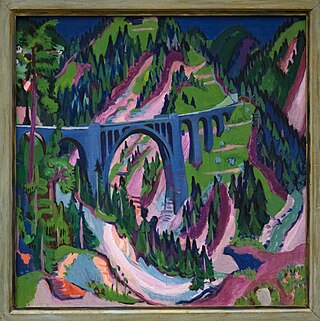
The Bridge near Wiesen, also known as The Bridge at Wiesen, is an oil on canvas painting by the German painter Ernst Ludwig Kirchner, from 1926. It depicts the Wiesen Viaduct, south of Davos, in Switzerland. It is signed on the bottom right of the center and is dated '26' on the back. The painting is held at the Kirchner Museum Davos.
